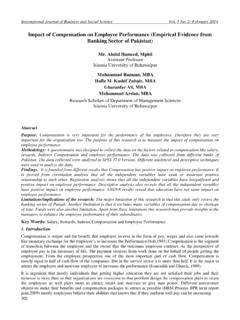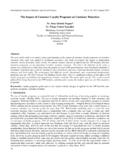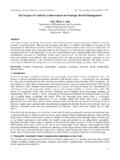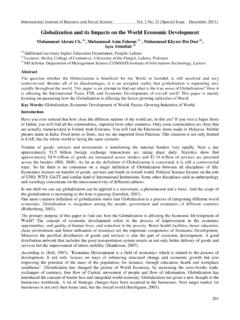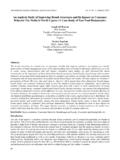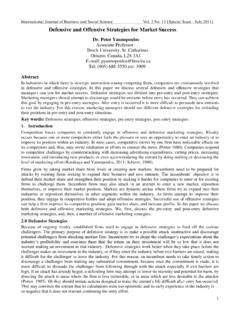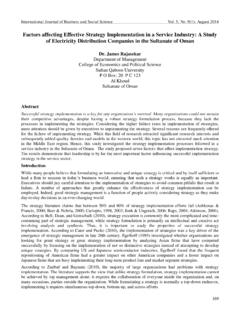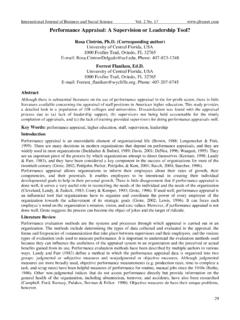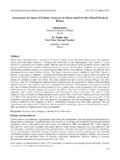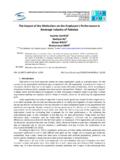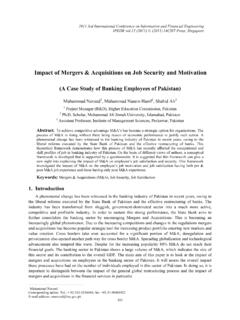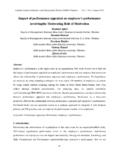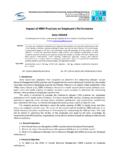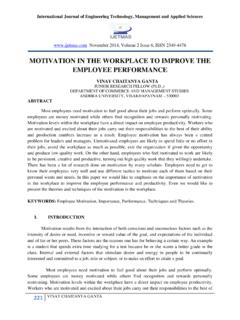Transcription of Of mission and vision statements and their potential ...
1 International Journal of Business and Social Science Vol. 3 No. 14 [Special Issue July 2012] 95 Of mission and vision statements and their potential impact on employee Behaviour and Attitudes: The Case of A Public But Profit-Oriented Tertiary Institution William Phanuel Kofi Darbi Ghana Institute of Management and Public Administration Business School Ghana Institute of Management and Public Administration Post Office Box AH 50, Achimota Accra, Ghana Abstract Research on mission and vision statements as strategic management tools has often been limited to private for-profit organisations and more so to the experience of senior executives and managers. This paper reports the perspectives of employees of a unique public but profit-oriented tertiary institution with a renewed corporate mandate in a developing country.
2 Based on a survey of 120 employees, this paper explored employees state of awareness of mission and vision statements , perceptions about their level of ownership and whether the institution s mission and vision statements impact /can impact on their behaviour and attitudes. The results indicated that most employees have first hand knowledge of the mission and vision statements though they do not frequently come across them; also the level of knowledge of the components/contents and perceptions about ownership are low. Employees see ownership as a prerequisite for the statements to impact on their behaviours and attitudes. Keywords: mission and vision statements , employee behaviour and attitudes, Strategic management, Public tertiary institution, Ghana Introduction mission and vision statements have been overwhelmingly accepted as an indispensable part of the strategic management process for organizations of all types; be it public sector, not-for-profit, private, for profit, a multinational or a small and medium scale enterprise.
3 It is widely believed that mission and vision statements impact on strategy and most aspects of organizational performance. Most firms have mission and vision statements . In the worst case scenario, mission and vision statements are implied implicitly. Supporting the above argument, Bart et al. (2001) posited, referring to Bain et al. (1996) study, that mission statements had consistently been shown to be the top-rated management tool deployed by senior managers during each of the ten years prior to his study. Mullane (2002) argued and supported it empirically that mission and vision statements are useful for practical day-to-day operations, taking a contrary view to those who assert they are archaic documents that are typically exhibited as wall hangings. Several works (Campbell, 1997; Mullane 2002; Rigby, 1994; Matejka et al.)
4 , 1993; Campbell and Yeung, 1991) have delineated how mission and vision statements can be used to build a common and shared sense of purpose and also serve as conduit through which employees focus are shaped. Other schools of thought believe mission and vision statements tend to motivate, shape behaviours, cultivate high levels of commitment and ultimately impact positively on employee performance (Mullane, 2002; Collins and Poras, 1991; Daniel, 1992, Campbell, 1989; Ireland and Hitt, 1992, Klemm et al., 1991, Drucker 1959). Having accepted at least notionally the potential strategic role of mission and vision statements , managers, researchers and academics have tried to explore empirically their importance, especially in terms of how the components impact on organizational performance since 1987 when the first attempt to investigate the relationship was made (see Pearson and David, 1987).
5 Yet most of the earlier empirical works have concentrated on senior executives and managers; if not investigating how they formulate their mission and vision statements then it is about how comprehensive their mission statements are and how they impact on performance. The perspective of the employee and, therefore, the larger work force has remained relatively neglected. The Special Issue on Social Science Research Centre for Promoting Ideas, USA 96 For instance despite the mission s significant and fundamental role in the management and leadership of organizations, we know relatively little about how employees perceive the missions and how these perceptions relate to other organisational attitudes such as satisfaction and behaviours such as turnover (Brown and Yoshioka, 2003).
6 While studies suggest that mission and vision statements have a positive impact on profitability and can increase shareholder equity, they also reported that almost 40 percent of employees do not know or understand their company's mission and vision (Bart and Tabone, 1998). There is therefore the need to explore and establish whether the case is widespread. This study is also motivated by the fact that Africa-specific cases are woefully lacking. The paper reports a study conducted among the workforce of a unique organization- a Ghanaian public tertiary institution that is profit-orientated to ascertain their perspectives on whether the institution s mission and vision statements impact or could potentially impact their behaviour and attitudes. More specifically, the research examined: The state of awareness of an existing mission and vision statements and its purpose.
7 The state of awareness of the content/components of mission and vision statements and how it relates to them as employees. Whether the institution s mission and vision statements impact or may impact their behavioural choices and attitudes. mission and vision statements : conceptual and definitional issues Many different organizations use different vocabularies to communicate strategy, some do so blatantly in an effort to portray uniqueness whilst others according to Sufi and Lyons (2003) confuse them unknowingly. There is no doubt in the strategic management literature about the distinctiveness of mission and vision statements . This notwithstanding it is not uncommon for organizations to capture their mission and vision statements in a single statement (see Sufi and Lyons, 2003) for that of Hilton hotels.
8 mission statements are widely believed to be antecedents to any strategy formulation effort (Thompson and Strickland 1992; Wheelen and Hunger, 1998; Lyles et al. 1993). More fundamentally, mission statements are supposed to capture the overriding purpose of an organization in line with the values and expectations of stakeholders and should typically answer the questions: what business are we in? (Johnson et al., 2008); and what is our business for? (Drucker, 1973). In furtherance of these arguments, mission statements are said to do a good job in capturing corporate level strategy in terms of scope, boundaries and value creation (Johnson, 2008; David; 1993). mission statements have been reported as a broad overarching framework around which other strategic concerns like vision , strategic intent and capabilities, goals, objectives, core values, behavioural standards, business models etc evolve (Campbell and Tawadey, 1992; Lynch, 2000).
9 The literature is inundated with those scholars who believe that before writing a mission statement, leaders in the organization must have an idea of what is in store for the future and thus the vision is the foundation for the mission statement. The vision provides a strategic direction, which is the springboard for the mission and related goals. Whilst this element of discourse exists, there is overwhelming consensus about the future orientation of a vision statement as opposed to that of a mission statement. Logically no organization wants to remain static; it is not uncommon to come across what is often referred to as a dream that a founder of an organization has. A vision is meant to evoke powerful and compelling mental images of the desired future states of their organizations.
10 Dreaming and aspirations about tomorrow is a defining tenet of entrepreneurial organizations as well as those organizations whose strategy formulation process could be described as entrepreneurial according to Mintzberg and Waters (1985). vision statements are supposed to be challenging and ambitious yet workable enough to evoke employees ingenuity as far as its realization is concerned. Core values are enduring principles, ideologies and worldviews that the founding fathers of organization hold in high esteem; these are sometimes referred to organizational vision (Sufi and Lyons, 2003). The enduring nature of these core values according to Sufi and Lyons (2003) must provide the toast for a vision for that matter. Authors such as Hussey (1998) and Mintzberg and Quinn (1996) explained that the vision statement should include core values or core ideologies that distinguish one organization from another.
